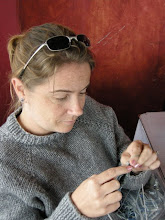I’ve been having some trouble getting started on this description of my time in Tbilisi; I didn’t really have a chance to get a good sense of the place, and don’t really see an obvious entry point to it. The thing that I liked the best about Tbilisi was the food, so I’ll try starting there, and see where we go.
Georgian food is really amazing. Historically, it isn’t surprising that it is so varied and creative. Georgia, over its history, was on the silk and spice roads from east to west. Just about anything can grow in its varied climates, and the country has been part of the Roman, Byzantine, Ottoman, and Soviet empires. Migrations and wars brought them into contact with many cultures of Europe, Asia, and the Middle East.
Some of the signature tastes of Georgian food are walnuts, paprika, and pomegranate. Red bell peppers, mushrooms, and eggplants provide the vehicle for pureed spreads of walnut and spices. Some of my favorite things were the minted cheese wrapped with pastry and soaked in minted yogurt, lamb-stuffed ravioli stewed in broth and topped with a bread lid, and the walnut and pomegranate stuffed braised trout.
Tbilisi is a very interesting city, and I feel that it was a shame that I didn’t get more time to explore the museums and older parts of it. The architecture ranges from a fortress built in the 13th or 14th century and religious buildings almost as old to post-Soviet modern glass buildings. On my last day there, one of the drivers took me sightseeing around Tbilisi and Mtsket, the old capital. It became clear why, as people in the office told me, Georgia was considered the tourism capital of the Soviet Union. Along the river and in the hills, there are beautiful buildings, decorated with intricately carved wooden balconies, and there are restaurants everywhere.
I found three buildings particularly interesting: town hall, a church, and the ministry of transportation. Town hall in Tbilisi looks like it was built during the period of heavy French influence, in the mid-19th century. My driver, however, insists that it is only 50 years old, and was built to look like it was very old. This remains to be confirmed, but that seems like an interesting story – why someone would go to the trouble and expense of building a town hall in the Soviet period to look like it was very old. I wonder if it has something to do with the tourist reputation of the country – it may have needed a town hall that was in keeping with its romantic image.
The Church we went to was beautiful and very very old. The driver who was with me thinks that it was probably built in the 15th or 16th century, but I think from being inside that it was built over at least two churches built previously. Georgia is made up mainly of Georgian Orthodox and Russian Orthodox Christians, and the church was set up like a Greek Orthodox church would be, with the altar behind a beautiful screen. The walls were painted with very intricate murals, but up to about six feet off the ground, all the faces were rubbed out of the saints, all the way around on every mural. I asked the driver why, but he just laughed at me and shook his head. Hmmm. The entire church was stunningly painted and carved and inlaid. Some of the interior walls had crumbled in places, revealing an earlier structure that was a bit smaller, and there were places in the floor covered with glass to reveal an even earlier site below.
Thursday, September 22, 2005
Subscribe to:
Post Comments (Atom)


1 comment:
I like your post. I never realized the diversity or type of foods there. If you happen to post pictures from your trip or have any interesting recipes, please, let me know.
Post a Comment